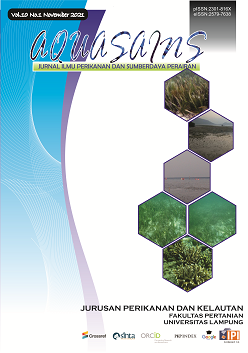Assesing local community to Existence of Local Marine Sanctuary “Kawasan Kelola Laut” in Saponda Island, Konawe Regency, Southeast Sulawesi
DOI:
https://doi.org/10.23960/aqs.v10i1.p1005-1014 Abstract View: 220
Abstract View: 220
Abstract
The study was conducted between February and June 2020. The pesence of local institution, which is responsible for marine and fisheries resource management known as “Kawasan Kelola Laut (KKL*)”, was the main reason why the study was carried out in Saponda Island. The objective of the study was to assess communtity preception on the presence of KKL*. Cluster random sampling method was selected by involving 94 respondents as representative of the perception. Principal component analysis (PCA) was selected, through which the relation between each respondent charateristic and level of perception was indentified. Result showed that respondent perception had positively correlated to meeting frequency (r = 0.67). the higher frequency of participant attended either formal or non-formal meeting, the better community perception would be formed. It was estimated thar respondent received more information and socializaton on the essential of KKL* during the meeting.
Keywords: Perception, Kawasan Kelola Laut, Saponda Island
Downloads
References
Baron RA and Byrne D. 2003. Social Psycology (5th edition). Alih Bahasa oleh Tim Psikologi Sosial, FPsi Universitas Indonesia. Jakarta: Erlangga.
Burbano DV, Meredith TC. 2020. Conservation Strategies Through the Lens of Small-Scale Fishers in the Galapagos Islands, Ecuador: Perceptions Underlying Local Resistance to Marine Planning. Society & Natural Resources, 33: 1–19.
Cinner J, Mamane MJ, McClanahan TR, Almany GR. 2005. Pertodic closures as adaptive coral reef management in the Indo- Pacif o. Ecology and Society 11(I): 31-38
Gruss A. 2015. Modelling the impacts of marine protected areas for mobile exploited fish populations and their fisheries: what we recently learnt and where we should be going. Aquatic Living Resources, 27(3): 107-133.
Halim A, Loneragan NR, Wiryawan B, Fujita R, Adhuri DS, Hordyk AR, Sondita MFA. 2020. Transforming traditional management into contemporary territorial-based fisheries management rights for small-scale fisheries in Indonesia. Marine Policy, 116: 1-15
Matsuda, Y., Satria, A., Sano, M. 2006. Questioning community-based coral reefmaztagement system. Case study of Awig-Awig in Gili Mudah, Indonesia. Journal of Environment, Development and Sustainability, 8: 99-118.
Mesnildrey L, Gascuel D, Pape OL. 2013. Integrating Marine Protected Areas in fisheries management systems: some criteria for ecological efficiency. Aquatic Living Resources, 26(2): 159 – 170.
Ostrom E. 1990. Governing the commons: The evolution of institution for collective action. Cambridge: Cambridge University Press.
Pita C, Horta e Costa B, Franco G, Coelh, R, Sousa I, Gonçalves EJ, Erzini K. 2020. Fisher’s perceptions about a marine protected area over time. Aquaculture and Fisheries, 5(5): 273-281.
Robinson A, Polunin N, Kvalvagnaes K, Halim M. 2004. Progress in creating a marine reserve system Inndonesia. Buletin of Marine Science 3 (3): 774-785.
Romero M,0 Saavedra S. 2020. Communal Property Rights and Deforestation. The Journal of Development Studies, 2020: 1-15
Satria A. 2009. Pesisir dari Laut untuk Rakyat. Bogor: IPB-Press.
Suartha IDM, Puspitosari H, Hemanto B. 2020. Reconstruction communal rights registration in encouraging Indonesia environmental protection. International Journal of Advanced Science and Technology, 29(3): 1277-1293.
Yayasan Bahari (YARI). 2005. Program Pengelolaan Ekosistem Terumbu Karang berbasis Masyarakat di Pulau Saponda Kecamatan Laonti Kabupaten Kendari Provinsi Sulawesi Tenggara. Laporan untuk GEF-SGP UNOP. Yayasan Bahari. Kendari.
Downloads
Published
How to Cite
Issue
Section
License
License for Authors
Authors who publish with this journal agree to the following terms:
- Authors retain copyright and grant the journal right of first publication with the work simultaneously licensed under a Creative Commons Attribution License that allows others to share the work with an acknowledgement of the work's authorship and initial publication in this journal.
- Authors are able to enter into separate, additional contractual arrangements for the non-exclusive distribution of the journal's published version of the work (e.g., post it to an institutional repository or publish it in a book), with an acknowledgement of its initial publication in this journal.
- When the article is accepted for publication, its copyright is transferred to Aquasains Journal. The copyright transfer convers the exclusive right to reproduce and distribute the article, including offprint, translation, photographic reproduction, microfilm, electronic material, (offline or online) or any other reproduction of similar nature.
- Authors are permitted and encouraged to post their work online (e.g., in institutional repositories or on their website) prior to and during the submission process, as it can lead to productive exchanges, as well as earlier and greater citation of published work (See The Effect of Open Access).
- The Author warrant that this article is original and that the author has full power to publish. The author sign for and accepts responsibility for releasing this material on behalf os any and all-author. If the article based on or part os student’s thesis, the student needs to sign as his/her agreement that his/her works is going published.
License for Regular Users
Other regular users who want to cite, distribute, remix, tweak, and build upon author’s works, even for commercial purposes, should acknowledge the work’s authorship and initial publication in this journal, licensed under a Creative Commons Attribution License.
This license lets others distribute, remix, tweak, and build upon your work, even commercially, as long as they credit you for the original creation.
This work is licensed under a Creative Commons Attribution 4.0 International License.Copyright Transfer Statement can be downloaded here


.png)









